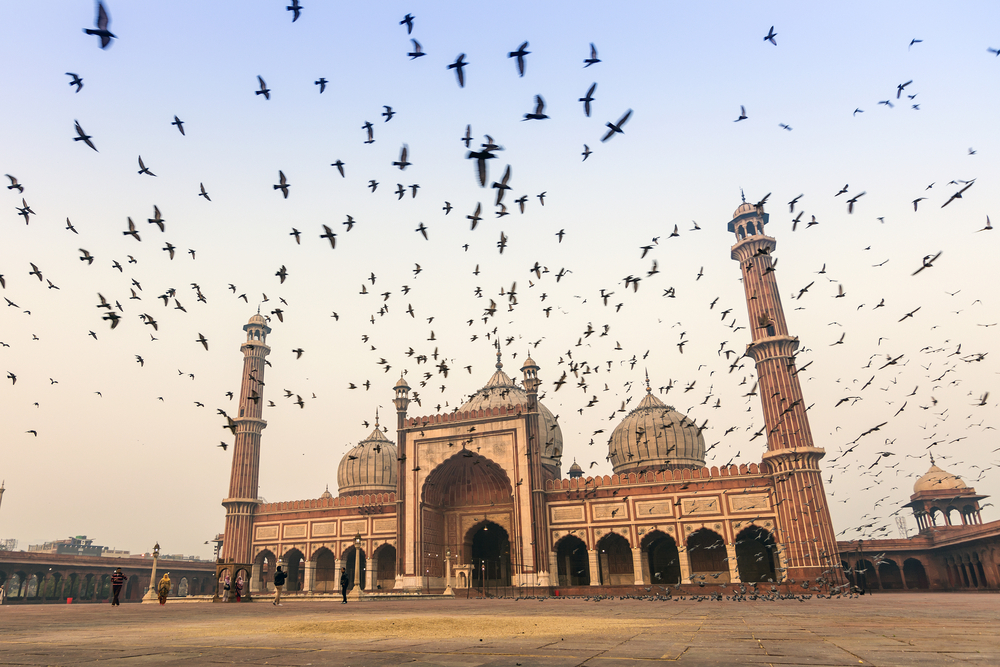
Everything You Want to Know About Delhi’s Jama Masjid
Many people believe that the Jama Masjid in Delhi is the most gorgeous mosque in all of India, and they have good cause to believe this. This massive building dated back to the 17th century and was constructed as part of Mughal Emperor Shah Jahan’s architectural extravaganza.
It can be found in the center of Old Delhi. Due to the mosque’s immense popularity, a visit to the nation’s capital city is not considered complete until it includes a stop at the building.
Table of Contents
The History of the Delhi Jama Masjid
Shah Jahan was the ruler of the Mughal Empire when he commissioned the construction of the Jama Masjid in the walled city of Shahjahanabad (also known as Old Delhi today), which served as the capital of the empire throughout his reign. The building of the mosque started in the year 1644 and continued for a total of twelve years till it was finally finished in the year 1656.
Saadullah Khan, the prime minister of the emperor, was in charge of supervising the work on the building site, which included more than 5000 laborers. This magnificent structure cost one million rupees to construct, even though Shah Jahan spared no money for its construction.
The first name given to the mosque was Masjid-i-Jahan Numa, which may be translated to mean “the Mosque that Reflects the World.” Later, it became known as Jama Masjid, which also translates as Friday Mosque.
Shah Jahan invited an Imam by the name of Abdul Ghafoor Shah Bukhari to come from Bukhara, which is today in the country of Uzbekistan, to perform the ceremony that inaugurated the mosque on July 23, 1656. In addition, Shah Jahan selected him to become the first Shahi Imam of the mosque.
Since its completion, the masjid has been proudly displayed in the city adjacent to the Red Fort, another well-known structure that Shah Jahan was responsible for constructing.
From the beginning of the Mughal period until its conclusion, it served as the imperial mosque for the royal family. Following the victory of the 1857 Rebellion, the newly installed British authorities took control of the mosque to destroy it.
However, because of the overwhelming protest from the general population, they were forced to rethink their choice, and the building was not damaged in any way. The Delhi Waqf Board is now responsible for managing the affairs of the masjid.
The architecture of the Delhi Jama Masjid
It is generally agreed that the Jama Masjid in Delhi is the most beautiful mosque built during the time of the Mughal Empire. With a length of around 261 feet and a width of approximately 90 feet, it was constructed out of red sandstone and white marble in an Indo-Islamic architectural style.
The building is embellished with three enormous arched gateways, three marble domes, four towers, and two minarets that are quite tall. In addition, it has a vast courtyard that can hold over 25,000 people simultaneously in prayer.
The only one of the three entrances to the mosque that has a stairway leading up to it is the entry that can be found on the eastern side of the building. Because the Mughal Emperors were the only people allowed to go through this gate, it is often referred to as the royal entrance.
On the northern and southern approaches, 39 and 33 stars lead up to the entrance gates. The combined height of the two minarets is up to 133 feet, and each has five stories and a balcony that extends out from the structure. There are 130 stairs leading up to the top of each minaret, the highest point on the structure.
The mosque’s floor is constructed out of black, and white marble intricately crafted and has 899 bordered portions designated for worshippers. The inside of this mosque has ornate archways, floral designs, and ornaments in brightly contrasting colors.
On the lintel of the archway that leads to the center of the prayer hall, the words “The Guide” are carved into the stone. One of the most important treasures discovered in the mosque is a copy of the Quran written on deerskin.
Facts About Jama Masjid, Delhi That Aren’t So Well Known
- One of Shah Jahan’s last feats of architectural mastery was the construction of the masjid.
- In the period of Shah Jahan, the eastern gate was the one that provided entry to the mosque for the Emperor. While the southern entrance was available for ordinary people, the northern gate was reserved exclusively for the use of the aristocrats.
- When constructing the layout for the Badshahi Masjid in Lahore, Shah Jahan’s son Aurangzeb was influenced by the design of this mosque.
- In the years leading up to the Revolution of 1857, the mosque served as the location of an on-site madrasa. It was ruined when the uprising was going on.
- In 1948, the previous Nizam of Hyderabad was asked for a contribution of 75,000 rupees so that repair work could be done on one-fourth of the floor of the tower. Instead, Nizam donated three lakhs of rupees, stipulating that the whole mosque floor must be restored so that no part of it seems outdated.
- The Jama Masjid in Delhi is not the biggest mosque in India, despite the widespread misconception to the contrary. The largest mosque on the list is the Taj-ul-Masjid in Bhopal, which can accommodate 175,000 people.
- Connaught Place and the Parliament Building are just across the street from the masjid.
Jama Masjid, Delhi: Today
One of the most popular destinations for visitors visiting Delhi is this mosque, which dates back hundreds of years. Because it is one of the biggest mosques in the nation, it is frequented by tourists and worshippers from all across India and even farther afield.
During the holiday of Id, when people assemble here to say their prayers (known in Arabic as namaz), the mosque is visited by many worshippers. Even though there are two minarets inside the mosque, only one located at the southern end is accessible to visitors for a small cost.
When night falls, the mosque is beautifully lit, making it a sight for sore eyes. To enter the mosque, you must first change into proper clothing. In addition, robes are available for rent at the northern entrance if you did not bring any.
Activities near Delhi Jama Masjid
There are several exciting things to do in the neighborhood of Jama Masjid in Delhi, India, particularly if you are a shopper or a gourmet. For example, you shouldn’t leave the neighborhood until you’ve had the wonderful kebabs served at legendary restaurants close to the mosque. You may also go shopping at Delhi’s Chandni Chowk market if you want some retail therapy.
Conclusion
Old Delhi, sometimes referred to as Delhi-6, is the neighborhood in which Jama
Masjid Delhi is located. It was constructed by Emperor Shah Jahan between 1644 and 1658 to foster global harmony.
This magnificent mosque can hold as many as 25,000 worshippers at one time. Around the Jama Masjid are several residential and commercial neighborhoods where you may purchase or rent a place to live, as well as enjoy going shopping and eating in the vicinity of the mosque.

Leave a Reply
You must be logged in to post a comment.